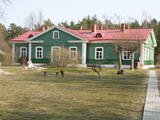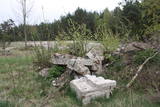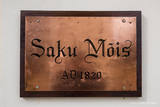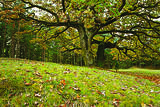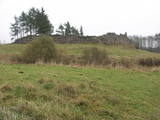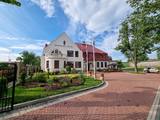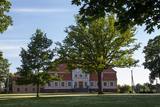| Nr | Name | Beschreibung |
|---|---|---|
|
Die Wirtin backt echtes lettisches Landbrot in einem mit Holz heizbaren Lehmofen. Der Teig wird aus Roggen- und Weizenmehl, Salz, Zucker, Kümmeln und natürlichem Sauerteig vorbereitet. Die Besucher können das Brotbacken beobachten und daran auch teilnehmen, sowie das Brot probieren und kaufen. Auf dem Hof kann man eine Altertümer-Sammlung besichtigen. Das zum Brotbacken verwendete Getreide ist aus dem eigenen Hof, wo es umweltfreundlich angebaut wird! |
||
|
This is an interesting viewing tower which is part of one of the farm buildings. It offers a lovely view of the surrounding area.
|
||
|
Dies ist der schwierigste Abschnitt des Forest Trail, insbesondere am zweiten Tag. Hier, an der Küste des Finnischen Meerbusens, erhebt sich der nordestnische Klint - eine steile, felsige und waldbedeckte Klippe, die sich nicht durchgehend nach Tallinn und weiter zu den Inseln Westestlands erstreckt. Der Forest Trail verläuft auf der Klippe und steigt gelegentlich in Täler ab. Es durchquert das tiefe und weite Pühajõgi-Tal im Toila-Oru-Park und kommt nach Toila, einem beliebten Küstenort. Einer der ungewöhnlichsten Abschnitte des Waldweges in Nordestland, der bei gutem Wetter am Fuße des beeindruckenden nordestnischen Klint entlang führt, steigt dann in den Dörfern Valaste und Saka auf den Gipfel des Klint und bietet atemberaubende Ausblicke auf der Finnische Meerbusen. |
||
|
Das ist ein langgestrecktes Gebiet zwischen der Ostsee und der Straße Kolka – Ventpils. Es beginnt an der Mündung des Flusses Irbe und endet in Ovīšrags. Das Territorium wurde vor allem eingerichtet, um den trockenen Koniferenwald, die Graudünen, Feuchtbegiete zwischen den Dünen, andere Landschaftserscheinungen, Pflanzen und Tiere in dem Gebiet zu schützen. Touristen lieben die sandigen und ruhigen Strände in dieser Gegend, die Leuchttürme von Miķeļbāka und Ovīši und die lutherische Kirche in Miķeļbāka. Hier gibt es auch noch einige Hinterlassenschaften des sowjetischen Militärsystems, die nicht touristisch genutzt werden.
|
||
|
The Cīruļi farm is in the Rings of Daugava Nature Park and in the village that is called "Lielie Muļķi" (Big Fools). The owners have more than 100 hives of bees, share experience, talk about the lives of bees and offer tastings and purchase of products. There is a chance to look and buy paintings by the owner who will talk about the "Lielie Muļķi" (Big Fools) village. |
||
|
Der Treibstofflager war früher Teil von dem Komplex der Militärobjekte gelegen in Pape. Heutzutage ist das Objekt verlassen und wird nicht genutzt.
|
||
|
Der Bauernhof wurde an der vom deutschen Baron von Hahn 1847 erbauten Wassermühle eingerichtet. Auf dem Bio-Bauernhof werden Dammhirsche und Forellen gezüchtet sowie Obst und Gemüse angebaut. Der Gastgeber ist ein Winzer, der mit großer Sorgfalt jedes Getränk zubereitet. Es werden Verpflegung, Führungen und Verkostungen angeboten. |
||
|
This is one of the most lovely and expressive castle hills in Latvia, with a very fine view of territory all the way to Lithuania. According to Ernests Brastiņš, a researcher of castle hills in Latvia, this was the site of the Semigalian Sidrabene castle. There are no improvements in the area.
|
||
|
Lauku sēta atrodas Džūkijas nacionālajā parkā. Saimniecībā iespējams pašiem ar saimnieces nelielu palīdzību pagatavot tradicionālos dzūku ēdienus veco laiku maizes krāsnī. Kulinārais mantojums un izglītības programmas. Piedāvā arī nakšņošanu. |
||
|
Alsunga wurde ursprünglich als Region Bandava schon 1230 in einem Vertrag des päpstlichen Gesandten mit dem Stamm der Kuren genannt. 1341 war Alsunga (deutsch: Alswangen, Kurisch: alšu vanga = Erlenlichtung) als „ein festes Haus“ benannt, 1372 begann der Bau einer aus Steinen gemauerten Burg in Form eines Vierecks, in dem der Fürst des Livonischen Ordens lebte, der dem Komtur von Kuldiga unterstand. Anfänglich wurde der östliche Korpus als Wohntrakt genutzt, der südliche als Wirschaftsflügel. Später, im 15. – 18. Jh. entstanden die Wehrtürme und die übrigen Teile des Schlosses. Die Ausmaße des Schlosses im Barockstil waren eindrucksvoll genug. Heute beherbergt es die Stadtverwaltung, ein Museum, ein Touristeninformtionszentrum und noch weitere Einrichtungen. |
||
|
Das Museum befindet sich in Aknīste, an der Kreuzung der Skolas Straße und Miera Straße. Dieses Museum ist noch ein Ort, der bei der Erkundung der Kultur und der Geschichte der Region Sēlija helfen wird. In dem Museum (eingerichtet im Jahr 1988) kann man eine Sammlung von Altertümern (aus der Steinzeit und Bronzezeit) und Gegenstände besichtigen, die über berühmte Persönlichkeiten aus der Gegend und die Kultur der Selen erzählen. Besonders wertvoll ist die Sammlung des Geschirrs der Selen. |
||
|
This manor is a prime example of classical architecture in Estonia. Since 2002 Saku manor is also a recreational centre. |
||
|
Die Bäckerin bäckt nach traditionellen Rezepten Brot und Sklandrausis auf Ahornblättern. Die Sklandrausis bestehen aus Roggenmehl, Kartoffeln und Möhren. In der Bäckerei wird der Prozess der Fertigung von Brot und Sklandrausis vorgeführt, woran anschließend die Besucher die frischen Erzeugnisse verkosten und kaufen können. Daneben werden traditionelle Trachten der Suiti, Spiele und Lieder gezeigt. |
||
|
In den historischen Quellen wurde das Dorf bereits 1582 erwähnt. Im Jahr 1736 waren im Gemeinderegister von Dundaga zwei Bauernhöfe in Vaide eingetragen: Lekši und Žonaki. Nach Angaben der Volkszählung im Frühjahr 1935 wohnten in Vaide 106 Menschen, darunter 40 Liven, 60 Letten, ein paar Esten und Deutsche. Am befanden sich im Dorf Vaide 21 Bauernhöfe. Auf dem Bauernhof Lāži von Vaide wurde der erste ausgebildete Live Nika Polmanis (1823–1903) geboren. Sein ganzes Leben verbrachte hier der livische Dichter Alfons Bertholds (1910–1993), der sein Gedicht einer neben dem Haus wachsenden Großeiche gewidmet hat. Mit dem Bauernhof Žonaki ist die große Familie Bertholds verbunden: die livische Erzählerin Marija Šaltjāre, der Segelschiffkapitän Andrejs Bertholds (USA), sein Sohn, der Bibliothekswissenschaftler Arturs Benedikts Bertholds (USA), der livische Dichter Alfons Bertholds, die livischen Sprachkenner Paulīne Kļaviņa und Viktors Bertholds, der Schweizer Arzt Marcel Berthold, der weltbekannte Pianist Arturs Ozolins (Kanada) und die livische Erzählerin und Dichterin Grizelda Kristiņa (1910–2013), die als letzte Muttersprachlerin der livischen Sprache gilt. Auch der Bauernhof Ozolnieki ist mit der Familie Bertholds, der Pflegerin livischer Traditionen und der Sprache Paulīne Kļaviņa (1918–2001) und deren Mutter, der livischen Erzählerin Katrīna Zēberga, verbunden. Die von Paulīne erstellte Sammlung der livischen ethnographischen Gegenstände ist im Lettischen Ethnographischen Freilichtmuseum, in der Scheune des livischen Bauernhofs „Dēliņi”, zu besichtigen. Im Bauernhof Purvziedi in Vaide ist eine Sammlung von Hörnern der Wildtiere zu sehen, die vom Förster Edgars Hausmanis gesammelt wurde. |
||
|
Dieses Gebiet wurde errichtet, um die kulturellen und Seelandschaften des zentralen Bereiches des Vizemer Hochlandes mit den Seen Alauksts, Inesis, Tauns, etc. und mit ihren Arten und Biotopen zu schützen. In diesem Territorium sind viele wichtige Kulturobjekte – in Vecpiebalga die lutherische Kirche, die Schloßruinen, der Gutshof, sowie die Orte, wo verschiedene bedeutende Personen des lettischen Kulturlebens gelebt und gearbeitet haben. Museen wurden eingerichtet, um ihrer zu gedenken. Die Seen sind großartig zum Angeln geeignet und Skilaufwettbewerbe werden traditionell im Seengebiet von Alauksts im Winter organisiert. Das Sproģi Naturreservat wurde auf den Inseln und Halbinseln des Sees Inesis eingerichtet.
|
||
|
Der Hof befindet sich nordwestlich (Richtung der Küste) von der Baptistenkirche von Pitrags. Kurgati ist eine Fischer- und Bauernwirtschaft, die in den 1930er Jahren gebaut wurde. Sie brachte neue Bauelemente in der von den Liven bewohnten Küste ein, weil ihre Dächer abgestumpfte Spitzen hatten, was den Häusern der livischen Dörfer nicht charakteristisch war. |
||
|
The only Art Nouveau building in Aluksne, built at the beginning of the 20th century, now works as a hotel. Historically, the building once housed a Railway hotel, so the original name of the hotel - "Bahnhofs Hotel" (transl. from German - "Railway" hotel) was kept. The hotel has 9 rooms (some of which extra beds can be arranged). At an additional cost an English-style breakfast is available. Hotel guests are offered a half-hour free access to the swimming pool at hotel "Jolanta", which is nearby, as well as electric scooter and bicycle rental. A banquet hall is also available for various events. N.B. Hotel bookings must be made at least 12 hours before arrival. |
||
|
Taka, kas izveidota Lemmjegi (Lemmjõgi) un Raudnas (Raudna jõgi) satekas vietā, iepazīstina ar palieņu pļavām un veciem pārmitriem mežiem, kas ir vieni no lielākajiem Igaunijā. Takas sākumā dominē atklātas lauku ainavas. Viens no 4,9 km garās lokveida takas apskates objektiem ir Lemjē dižozols. Mitrā laikā noderēs ūdensizturīgi apavi. |
||
|
Der breiteste Wasserfall im Baltikum ist etwa 249m breit und bis zu 1,75m hoch. Er ist sowohl als Naturerscheinung als auch vom kulturwissenschaftlichen Aspekt interessant, denn er ist Schauplatz mancher Ereignisse und Sagen. Hier wäre auch eine von Herzog Jakobs erfundene Fischfangvorrichtung zu erwähnen, die an den Felsvorsprüngen des Wasserfalles befestigt war. So entstand auch die Geschichte von einer Stadt, in der Lachse in der Luft gefangen werden. (Lachse und Zährten sprangen während der Laichwanderung flußaufwärts über den Wasserfall und gerieten so in die Netze). Um die Schifffahrt auf der Venta zu ermöglichen, wurde bereits zu Herzog Jekabs Zeiten begonnen, einen Kanal am Wasserfall entlang zu bauen. Zu Beginn des 18. Jh. verbreitete sich die Idee, eine Verbindung zwischen dem Schwarzen Meer und der Ostsee über die Venta, Memel und den Dnjepr zu schaffen.Aus diesem Grund mußten türkische Kriegsgefangene den Kanal weiter graben, was aber durch Dolomitfelsen erschwert wurde. Nach Sprengungen entstanden Risse in den umliegenden Gebäuden, daher wurden die Arbeiten eingestellt. Der imposante Graben ist auch heute noch zu sehen. Um die Besichtigung des Wasserfalls zu erleichtern, wurde 2012 am rechten Ufer der Venta ein Holzsteg errichtet. Eine Fahrt hierher lohnt sich zu allen Jahreszeiten, besonders aber zu den Laichwanderungen der Zährten (im Frühling) und der Lachse (im Herbst). |
||
|
Das Schloss Kelmė ist eines der wenigen in Litauen erhaltenen typischen Provinzresidenzen im Barockstil. Die gesamte Anlage ist in einem Konzept angelegt und mit vielen Originalgebäuden und den ursprünglichen Teichen und Grünanlagen gut erhalten. Der Park hat mit seiner strengen geometrischen Anordnung, aufgeteilt durch rechtwinklig angelegte Alleen, klare Barockeigenschaften. Es gibt einen künstlich angelegten Aussichtshügel. Der Großteil der älteren einheimischen Bäume (Eichen, Ahorn, Linden, Eschen) sind noch Erbe des ursprünglichen Parks. Die größten Prunkstücke des Parks sind der große Teich hinter dem Schloss zusammen mit drei kleineren Teichen und der Aussichtshügel im alten Park. |
||




